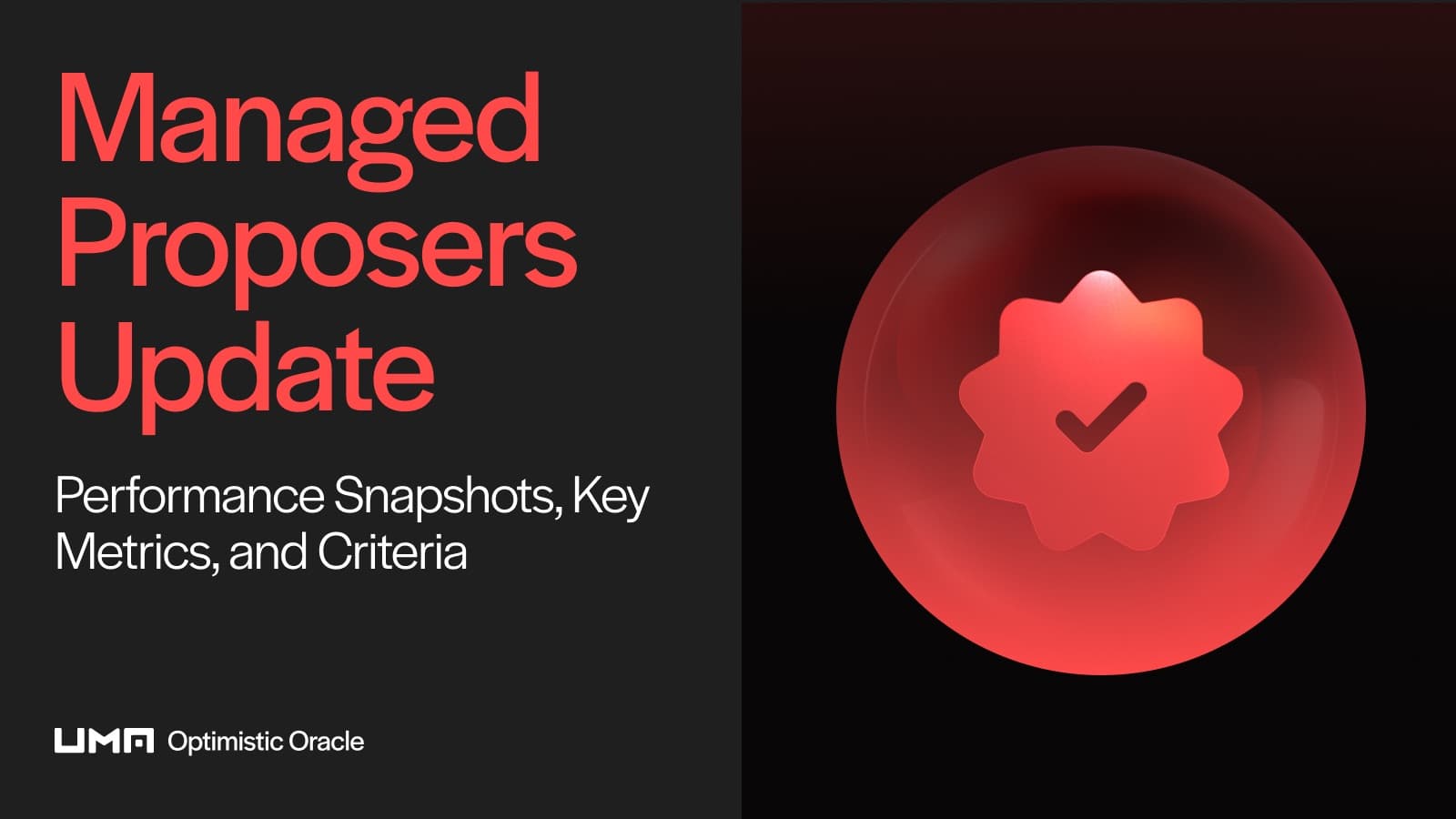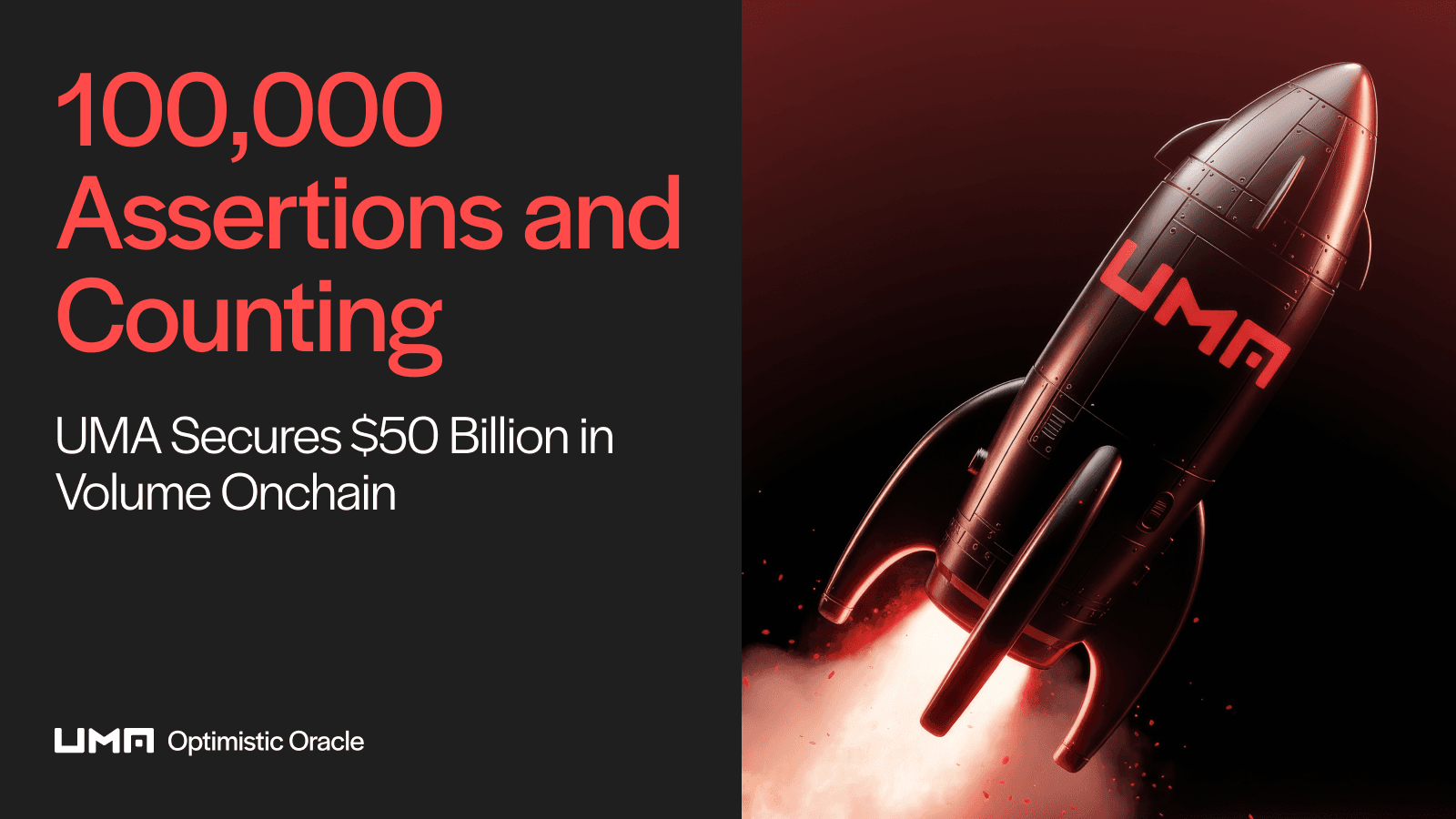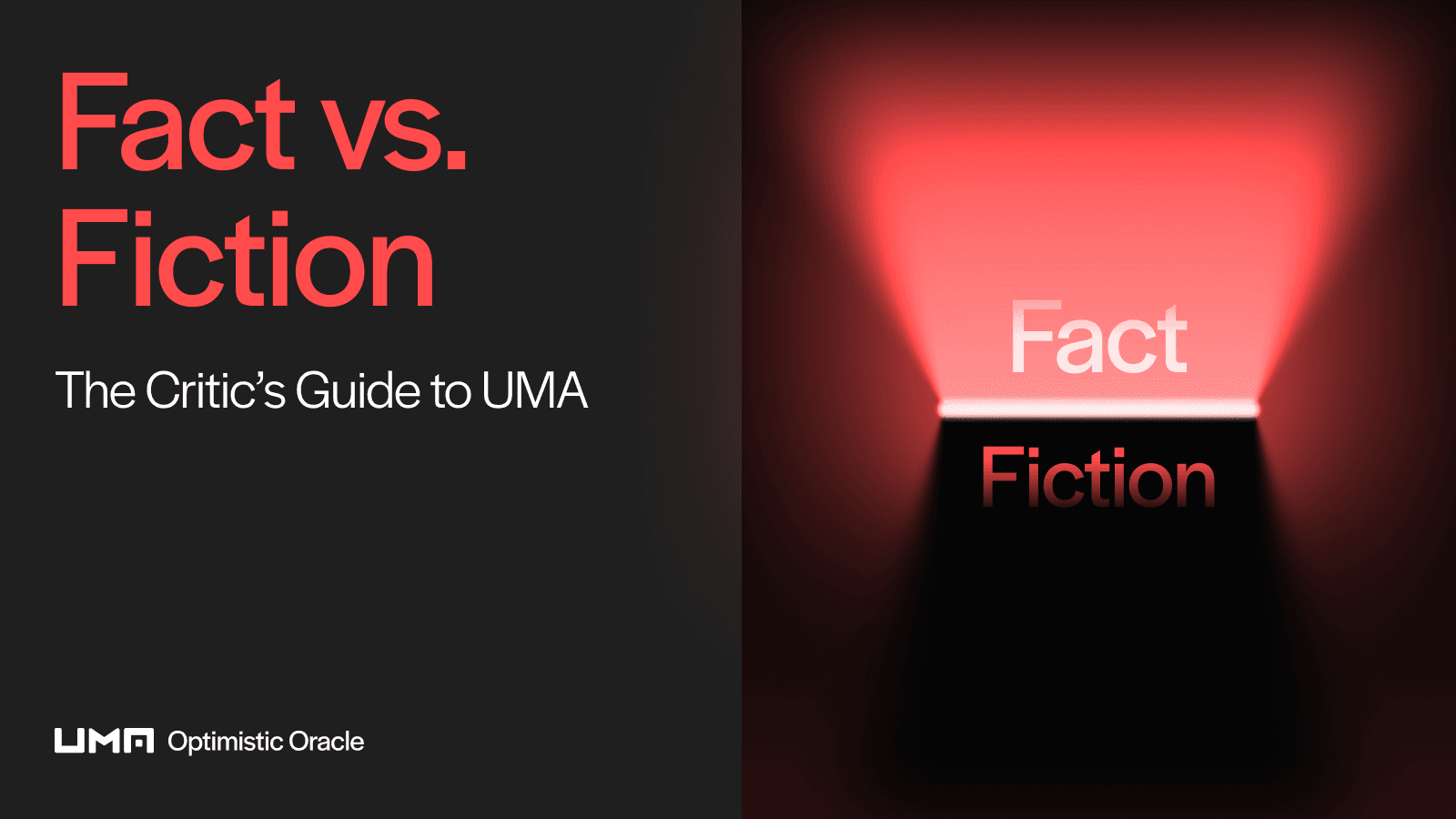What is UMA’s Optimistic Oracle?
Introduction
How do we determine the truth onchain?
In DeFi and web3 at large, access to accurate real-world and offchain data is essential. Whether it’s settling a prediction market, verifying a crosschain transaction, or securing governance decisions, smart contracts require external data to function correctly. But how do we ensure that this data is accurate and trust-minimized?
This is where UMA’s optimistic oracle (OO) comes in. Designed to provide flexible and cost-efficient data verification for protocols and dApps, the OO has quickly become the industry standard oracle for bringing real-world truth onchain. Let's take a closer look.
What Is a Blockchain Oracle?
Before we get into the meat and potatoes, here's a quick refresher on blockchain oracles. A blockchain oracle is a service that brings real-world data onchain, allowing smart contracts to interact with external information.
Consider Polymarket, a decentralized prediction market. If users place bets on real-world events—such as an election outcome—the market needs an oracle to determine the correct result and settle payouts. Without an oracle, these markets wouldn’t function.
This is the case for any protocol or dApp that relies on external data to execute a smart contract use case.
The Problem with Traditional Oracles
Traditional oracles play a critical role in onchain applications, but existing solutions face several challenges and limitations:
Data reliability – DeFi and other web3 applications require reliable external data to function. However, ensuring accuracy is difficult. Inaccurate or manipulated data can lead to disastrous outcomes like improper liquidations, mispriced assets, or broken contracts.
Long-tail and arbitrary data: Most oracles are optimized for streaming objective data (e.g. token prices) but cannot process custom, event-specific, or natural language data requests.
Cost inefficiency: Most oracles are push-based, meaning they continuously publish data onchain whether it's needed or not—often at a high cost.
Multichain challenges: Many protocols and dApps exist on multiple chains, but most oracles don’t offer seamless multichain support.
Centralization risks: Many solutions rely on permissioned entities to determine truth, which introduces trust and censorship risks.
UMA’s OO takes a different approach to address these issues.
UMA’s Optimistic Oracle (OO): A Decentralized Solution
UMA's OO is a decentralized, human-powered data verification system. It operates on an optimistic model, meaning data is optimistically considered true unless disputed. Disputed data is resolved by a permissionless voting mechanism open to participants from anywhere in the world. The combination of optimistic verification and consensus-based dispute resolution enable the OO to provide accurate data to smart contracts and web3 applications in a cost-efficient and secure manner.
Unlike traditional oracles, the OO specializes in verifying real-world and offchain data by verifying natural language statements. This level of flexibility enables a wide range of ever-evolving use cases across the web3 landscape. As of today, the OO has secured billions of dollars in value across DeFi, prediction markets, DAOs, and more. Let's explore how it works.
How the Optimistic Oracle Works
When data is submitted to the OO, it is optimistically published onchain and resolved as true unless disputed. Disputed data is resolved by a decentralized community of UMA stakers who vote on its accuracy. However, disputes are rare, and more than 98% of proposals go undisputed.
In order to ensure integrity across all levels within this system, UMA leverages economic incentives to ensure all participants behave honestly and promote data accuracy.
Requesters (e.g. dApps, prediction markets, etc.) submit data requests to the OO. Requests contain specific offchain information that needs to be verified and resolved onchain, along with the parameters that define its accuracy. UMA facilitates this process by resolving and verifying the requested information.
Proposers submit answers (data proposals) to requests made to the OO. Proposals must be accompanied by a financial bond to maintain economic security. After a proposal is submitted to the OO, it enters a 48-hour challenge window where anyone can dispute it. Proposers earn a small reward for proposing accurate data; However, they lose their bond if their proposal is disputed and resolved as false.
Disputers can challenge any proposal they believe is incorrect by matching the proposer’s bond. If a dispute arises, the proposal is escalated to UMA’s Data Verification Mechanism (DVM), where UMA voters collectively determine the correct resolution. Disputers earn a small reward for disputing false proposals; However, they lose their bond if their dispute is resolved in favor of the proposal.
Verifiers (formerly known as the “verification team”) assess submitted proposals by providing supporting evidence. They receive rewards (sponsored by UMA) for accurate verifications and face penalties for incorrect ones. If a verifier identifies an inaccurate proposal, they can raise an offchain dispute alert to inform disputers and the UMA team. Learn more about UMA verifiers here.
Voters, who are UMA token stakers, participate in reviewing disputed proposals through decentralized and shielded voting. Their consensus determines the final outcome. Voters earn incentives for accurate participation and face penalties for incorrect or missed votes. For further details, refer to the voting guide and FAQ.
UMA's economic design ensures that truth-telling is both incentivized and profitable, making it the most trusted solution for onchain data verification. This approach ensures a high level of security—malicious actors face penalties while correct data is reinforced, making the oracle both cost-effective and robust for various applications.
How the Optimistic Oracle Addresses Key Issues
Earlier, we listed several key problems that traditional blockchain oracles face. Here's how the OO solves each of them.
Ensures data reliability: The OO enables any onchain application to request and verify real-world data, ensuring smart contracts can function with accurate information.
Verifies long-tail and arbitrary data: The OO can verify custom and specific data requests such as election results, sports outcomes, and more.
Processes multiple types of data: UMA is designed to process and verify objective data, as well as intersubjective data—information that is agreed upon by a group of individuals based on shared beliefs, interpretations, or social consensus rather than purely objective or subjective criteria.
Minimizes costs: Optimistic verification provides both speed and cost-efficiency. Requests and proposals are always published onchain. Undisputed requests are cheap and fast because they don't require a voting resolution. Only ~1.5% of proposals get disputed.
Supports multichain web3 applications: The OO is compatible with multiple blockchains, allowing seamless deployment across different networks. View the full list of supported chains here.
Eliminates centralization risks: Open participation and decentralized consensus mechanisms ensure that no single entity has control over data verification.
Promotes economic security: Economic incentives ensure that honest behavior is profitable and dishonest behavior unprofitable.
How Developers Can Build With the Optimistic Oracle
The OO is used across multiple smart contract use cases, including:
Prediction markets
Crosschain infrastructure
Content moderation
Transaction verification
Governance
Sports betting
Insurance
By integrating the OO, developers gain a powerful oracle integration that empowers them to offload the work of data verification and dispute resolution in a decentralized, efficient, and secure manner.
Enhancing Prediction Markets, Sports Betting, and DeFi
Prediction markets, such as Polymarket, rely on UMA for accurate and efficient oracle resolutions to settle event-based contracts—sometimes multiple at once. To address this, UMA released UMIP 183: an OO upgrade that introduces the MULTIPLE_VALUES price identifier to enable single data requests to return up to seven values. This drastically reduces gas fees and simplifies resolution processes, making it easier for prediction markets to handle multiple events in one transaction.
In sports betting, UMIP 183 allows platforms to batch-resolve game outcomes. This ensures fast, cost-effective settlements while maintaining full decentralization, and opens the door for seamless, onchain betting experiences secured by UMA.
Additionally, DeFi protocols can leverage UMA’s OO to validate onchain transactions securely. For example, Across has used the OO to verify and settle about $20 billion in crosschain transactions. Other use cases, such as insurance and governance, similarly benefit from UMA’s efficient model, reinforcing its position as the ultimate smart contract oracle for diverse applications.
Optimistic Oracle Versions and Use Cases
UMA’s OO is constantly being improved to evolve and serve in-demand use cases over time. Currently, there are two versions of the OO available: OOV2 and OOV3.
OOV2
OOV2 implements the use of data requests. Integrations must submit data requests that can then be answered by third-party proposers. Rules must be included in the request to establish the specific parameters for proposers and disputers to follow.
The primary use cases for OOV2 include prediction markets, sports betting applications, and insurance protocols.
OOV3
Unlike OOV2, OOV3 doesn’t implement data requests. Instead, integrations skip that step and submit their own data proposals along with the rules. The challenge period and dispute process remains the same.
The primary use cases for V3 include crosschain infrastructure, content moderation, transaction verification, governance, and insurance protocols.
Key takeaway:
Build with OOV2 if your protocol needs third-parties to propose answers to data requests.
Build with OOV3 if your protocol simply needs to assert data to be verified.
Get Started With the Optimistic Oracle
UMA’s OO is a scalable oracle solution that empowers developers to build trust-minimized smart contract applications in a decentralized, cost-efficient, and secure manner.
Explore the following resources to start integrating the OO:
Ready to integrate the Optimistic Oracle? Start building today.


